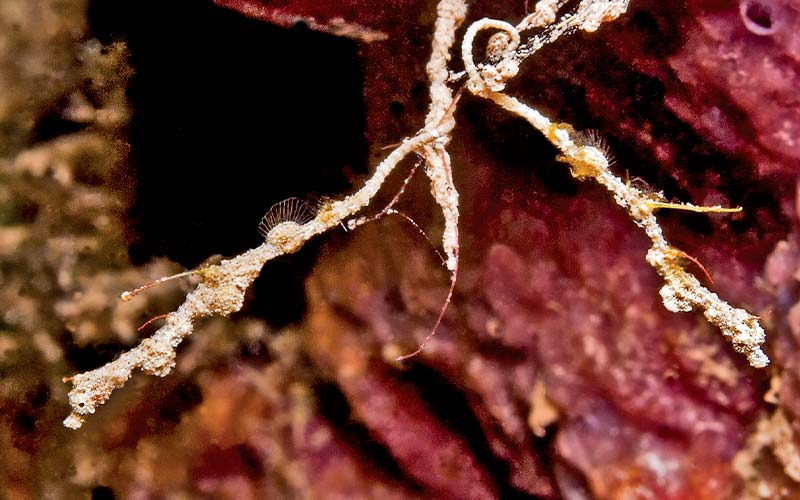Noldy Rumengan slips over a coral ridge and eases down the slope, heading for a patch of algae and hydroids at 50 feet. Although unappealing to the eye, such dreary scraps of coastal terrain are prime real estate for critters, as the veteran dive guide has learned through years of experience. Rumengan ranks among the finest critter hunters; over the decades his talents have teased out a carnival of eye-popping animals from similar tangles, but none are as deliciously unimaginable as the pair of pin-sized pipehorses he is about to discover here in Lembeh Strait.
It is difficult to convey the patience required to find a tiny, well-camouflaged animal underwater. Rumengan carefully sorts through the snarls of algae stem by stem, constantly on the lookout for the slightest movement and the telltale outlines of eyes and claws. Minutes or possibly a half hour later his eyes lock on a twitch. Leaning closer, his mind struggles to make sense of a crusty strand dangling from the growth. The thread unexpectedly lifts free and floats as light as a feather toward a neighboring stem, where it reattaches just above a second thread of similar size and shape. A sense of joy overcomes him as he contemplates from only inches away the pair of unfamiliar little life forms. Could this be a new species, possibly a pygmy seahorse? If so, what a prize!

By the time Rumengan’s motorbike rattles him back across the northern isthmus of Sulawesi separating Lembeh Strait, the site of the discovery, from his home in Manado, it is approaching midnight. The late hour doesn’t deter him from sharing his discovery with longtime friend and dive companion William Tan in Singapore. Tan is an accomplished artist with both camera and violin. When away from the Singapore Symphony Orchestra, he is usually underwater, most often diving with Rumengan. The years of teamwork have paid big dividends, producing a plethora of peerless marine wildlife images for magazines and large-format books.
A week later the partners tumble out of a skiff and retrace Rumengan’s descent to the patch at 50 feet. Now armed with a search image, Rumengan quickly locates the pair not a hand’s length away from where he left them. Even though thoroughly briefed, the one-inch animals’ slight frames take Tan aback. Compounding the challenge of the photographic mission, strings of vegetation keep drifting in front of his lens, and the shy subjects invariably turn away. It is only later, after the dive, when viewing the fish on a computer screen that the unique nature of their body shape becomes apparent. The animals don’t appear to be seahorses but rather close relatives in the same family, Syngnathidae. They’re pipehorses — a cross in form between the stocky and more curved seahorse profile and the thin, nearly straight bodies of pipefishes.
Days later, images of Tan’s and Rumengan’s mysterious pipehorse flash across Rudie Kuiter’s screen in Seaford, Australia. The Syngnathidae expert doesn’t have to scrutinize the photos for more than a minute before feeling confident he is looking at a new species. Even more exciting, the anatomy of the little fish is so novel that the animals could represent a new genus to boot.
If Tan were a dancing man, he would have broken into a jig after reading Kuiter’s congratulatory note. But the path to establishing a new species isn’t over yet. A photograph, no matter how detailed, will not suffice. The time-honored (and time-consuming) process of describing and naming a species requires an exhaustive examination of the anatomical features of an in-hand specimen by a taxonomic specialist. The specialist must compare his litany of minute findings with all previous literature dealing with known members of the family. This work is then presented with charts, graphs and drawings as a comprehensive manuscript that undergoes much fuss and scrutiny from a panel of peers before finally receiving approval for publication in a scientific journal.
Kuiter’s message ends with a request: If a specimen can be made available, his colleague, Martin Gomon, senior curator (ichthyology) at Museum Victoria, would be willing to tackle the descriptive work. One year later, in October 2007, “A new genus and miniature species of pipehorse (Syngnathidae) from Indonesia” appears in aqua: International Journal of Ichthyology — another addendum to the catalog of life, realized with the help of divers. And, adding an additional plum to the pudding, critter hunters have a splendid new animal to keep an eye cocked for — Kyonemichthys rumengani. The genus name, meaning “swollen thread” in Greek, is quite appropriate; the species name, even more fitting, honors Noldy Rumengan.
© Alert Diver — Q1 Winter 2012